Lessico
Beccaccia
Scolopax rusticola
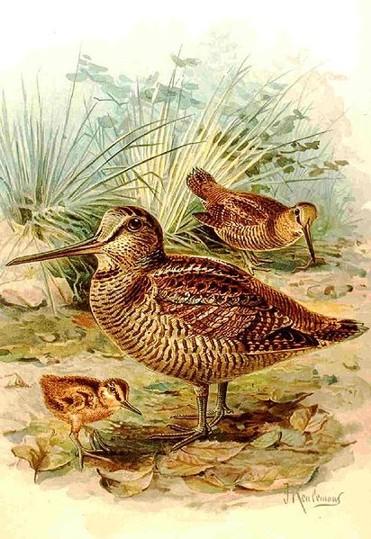
Beccaccia
significa dal lungo becco![]() . Denominazione di diversi Uccelli e in particolare
di Scolopax rusticola, della famiglia Scolopacidi. Lunga sino a una
quarantina di centimetri, la beccaccia presenta un piumaggio di colore simile
a quello delle foglie appassite, perfettamente criptico nei confronti
dell'ambiente in cui vive. La beccaccia, infatti, frequenta i boschi umidi,
con sottobosco assai fitto; quasi inattiva durante il giorno, al tramonto e
all'alba va alla ricerca di vermi, insetti e altri invertebrati che scova nel
terreno immergendovi il lungo e sottile becco. La specie, di indole
decisamente solitaria, si riproduce per lo più due volte, in primavera e agli
inizi dell'estate, deponendo sino a 4 uova in un avvallamento del terreno
rivestito in precedenza con materiali vegetali. Diffusa in buona parte
dell'Europa e dell'Asia, la beccaccia migra in autunno verso sud. In Italia è
di passo in autunno e agli inizi della primavera. Fa parte della cacciagione
gastronomicamente più pregiata. La sua carne succulenta e saporita necessita
di una breve frollatura; le interiora sono in genere cucinate insieme
all'animale, ma talvolta servono per preparare gustosissimi crostini di sapore
leggermente amarognolo. Le beccacce si preparano arrostite, farcite, in
casseruola, in salmì, ecc.
. Denominazione di diversi Uccelli e in particolare
di Scolopax rusticola, della famiglia Scolopacidi. Lunga sino a una
quarantina di centimetri, la beccaccia presenta un piumaggio di colore simile
a quello delle foglie appassite, perfettamente criptico nei confronti
dell'ambiente in cui vive. La beccaccia, infatti, frequenta i boschi umidi,
con sottobosco assai fitto; quasi inattiva durante il giorno, al tramonto e
all'alba va alla ricerca di vermi, insetti e altri invertebrati che scova nel
terreno immergendovi il lungo e sottile becco. La specie, di indole
decisamente solitaria, si riproduce per lo più due volte, in primavera e agli
inizi dell'estate, deponendo sino a 4 uova in un avvallamento del terreno
rivestito in precedenza con materiali vegetali. Diffusa in buona parte
dell'Europa e dell'Asia, la beccaccia migra in autunno verso sud. In Italia è
di passo in autunno e agli inizi della primavera. Fa parte della cacciagione
gastronomicamente più pregiata. La sua carne succulenta e saporita necessita
di una breve frollatura; le interiora sono in genere cucinate insieme
all'animale, ma talvolta servono per preparare gustosissimi crostini di sapore
leggermente amarognolo. Le beccacce si preparano arrostite, farcite, in
casseruola, in salmì, ecc.
Scolopax rusticola
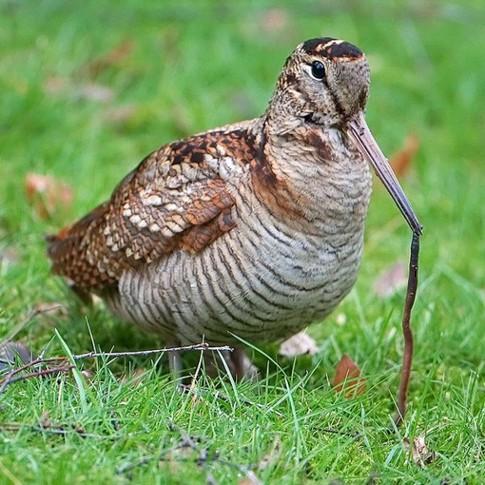
La Beccaccia (Scolopax rusticola Linnaeus 1758) è un uccello dell'ordine dei Caradriformi, famiglia degli Scolopacidi. Scolopax in greco suona skolópax la cui etimologia sarebbe da ricondurre a skólops che indica un oggetto appuntito come lo è di norma un piolo, quindi con chiaro riferimento al becco. La beccaccia ha 2 sottospecie: Scolopax rusticola rusticola e Scolopax rusticola ultimus. È caratterizzata da un becco a punta di 6-8 cm e un peso tra i 250 e i 350 g, ha una colorazione mimetica che ben si adatta all'ambiente che frequenta, quindi colore marrone variamente barrato di nero e giallastro.
L'areale della beccaccia euro-asiatica comprende l'Europa fino alle isole atlantiche (Azzorre, Canarie) e le isole britanniche, l'Asia fino alla Cina, Mongolia, e Tibet. In Italia si trova nel periodo dello svernamento, tra ottobre e marzo, nei boschi, meglio se misti a caducifoglie, con prevalenza di betulle, carpini, frassini, querce, robinie, castagni, ontani, larici e faggi, ma anche abeti e pini. In primavera nidifica in un'ampia fascia di territorio che comprende il nord Europa e l'Asia centrale. Solo eccezionalmente nidifica sulle Alpi e ancor più raramente sugli Appennini.
Uccello insettivoro, si nutre essenzialmente di insetti, vermi e larve. Il cibo viene cercato con la sensibilità del becco direttamente nel sottosuolo del bosco. Il nido della beccaccia è abbastanza semplice, viene fatto per terra in depressioni del terreno e imbottito di tutto ciò che trova, foglie secche, rametti, fili d'erba. Deposita in media quattro uova, che schiudono dopo tre settimane di incubazione.
In Italia è specie cacciabile ed è considerata la regina del bosco tanta è la sua maestosità, la difficoltà nella cattura e la squisitezza delle carni. In passato ne era autorizzata la caccia anche all'alba e al tramonto, la cosiddetta posta, durante gli spostamenti per i luoghi di pastura. Oggi tale pratica, detta la posta infame,tecnica di caccia assolutamente antisportiva, è proibita poiché in quelle occasioni la beccaccia risulta essere particolarmente vulnerabile per il volo troppo regolare e quasi a farfalla, differenza di quando invece viene cercata e insidiata con il cane da ferma. È qui che essa usa tutta la sua abilità mettendo in atto varie tecniche per nascondersi all'olfatto del cane e, quando costretta a involarsi, riesce a rendersi quasi imprendibile al cacciatore utilizzando le sue grandi doti di volo veloce e zigzagante. A partire dal 1800 è stata selezionata una razza di cane, il Cocker Spaniel inglese, oggi apprezzato come cane da compagnia, ma un tempo specializzato nella caccia alla beccaccia (Woodcock in inglese), che ha dato appunto il nome alla razza. Nelle piume dell'ala della beccaccia esiste una particolare penna detta pennino del pittore che appunto serve ai pittori per le rifiniture di precisione sulle tele.
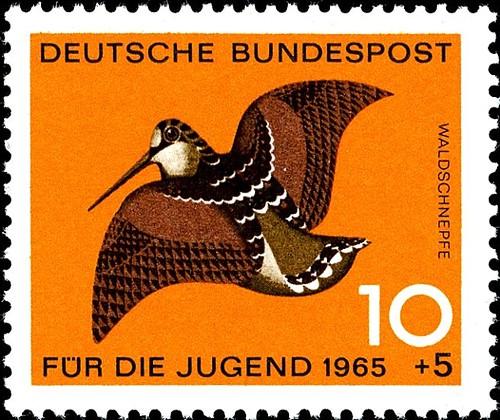
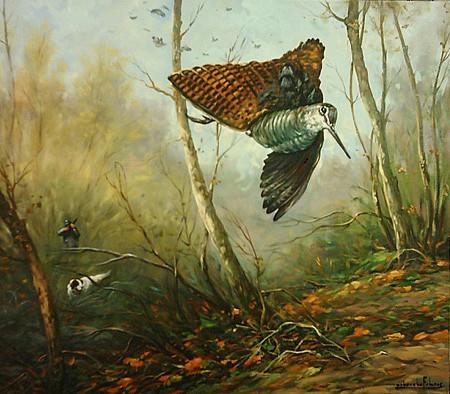
The Eurasian Woodcock, Scolopax rusticola, is a medium-small wading bird found in temperate and subarctic Eurasia. It has cryptic camouflage to suit its woodland habitat, with reddish-brown upperparts and buff-coloured underparts. Its eyes are set far back on its head to give it 360-degree vision and it probes in the ground for food with its long, sensitive bill, making it vulnerable to cold weather when the ground remains frozen. The male performs a courtship flight known as 'roding' at dusk in spring. When threatened, the female can carry chicks between her legs, in her claws or on her back while flying, though this is rarely witnessed. The world population is estimated to be 15 million to 16 million birds.
Adults are 33–38 centimetres (13–15 in) in length, including the 6–8 centimetres (2.4–3.1 in) long straight bill, and have a 55–65 centimetres (22–26 in) wingspan. The Eurasian Woodcock has cryptic camouflage to suit its woodland habitat, with intricately patterned reddish-brown upperparts and buff underparts. The head is barred with black, not striped like that of its close relatives, the snipe. It has large eyes located high on the sides of its head, giving it 360-degree monocular vision. The wings are rounded and the base of the bill is flesh-coloured with a dark tip. The legs vary from grey to pinkish. The species is sexually dimorphic, with the male much larger than the female, although the sexes cannot be separated in the field.
The
Eurasian Woodcock was given its current scientific name by Linnaeus in his Systema
naturae in 1758. The binomial name is derived from the Greek skolopax,
meaning 'woodcock', and Latin rusticus ('rural') and colere ('to live'). The
species is monotypic and its closest relatives are the other woodcocks in the
genus Scolopax.
About one third of the world's Eurasian Woodcock breed in Europe, with more
than 90% of the continent's population breeding in Russia and Fennoscandia.
Their breeding range stretches from Fennoscandia to the Mediterranean Sea and
Canary Islands and from western Europe to Russia. This species is the woodcock
found through most of temperate and subarctic Eurasia. Northern and Asian
populations migrate to southern Europe or south Asia respectively. Birds in
milder western European countries and on Atlantic islands are resident. The
populations breeding in north-west and southern Europe are mostly sedentary.
The birds' spring migration commences in February; breeding territories are
reached between March and May. The Eurasian Woodcock has a large range, with
an estimated Global Extent of Occurrence of 10 million square kilometres and a
population of an estimated 15 million to 16 million birds. Because of its
large range, stable population trend and large population size, the species
has been evaluated as Least Concern. The most important threat to the
population of the Eurasian Woodcock in the breeding range is the increased
fragmentation of its woodland habitat. At other times of year, a reduction in
the amount of permanent grassland and an increase in the intensification of
farming are also threats, and the species' susceptibility to avian influenza
may have an impact in future.
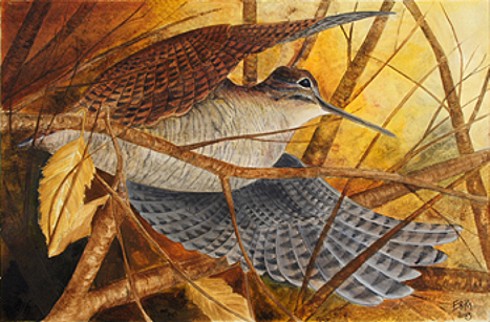
The Eurasian Woodcock's required breeding habitat is large, unfragmented areas of broadleaved deciduous or mixed broadleaved and coniferous forest, with dense undergrowth of plants such as Brambles, Holly, Hazel, Gorse, Bracken or Bilberry. Breeding territories must include a mix of dry, warm resting places, damp areas for feeding, and clearings for flight. In larger woods, wide 'rides' (open tracks through the wood) and small clearings are important. In winter, Eurasian Woodcock also use scrubland during the day but in freezing weather they may use intertidal mud.
Eurasian Woodcock are crepuscular (most active at dawn and dusk) and rarely active during the day unless flushed, when they fly off with a whirring wing noise. The flight is somewhat owl- or bat-like; Woodcock fly fast and direct while migrating or crossing open country, but fly erratically with twisting and fluttering once in woodland. They are usually solitary and migrate singly, but may congregate when weather or geographical conditions force them to do so. The male performs a courtship display flight called 'roding' at dusk between April and June. Flying over the treetops with flickering wings and downward-pointing bill, it utters several deep croaks followed by a sharp squeak; the grunts are at a frequency of between 0.6 to 1.5 kHz and the squeaks range from 3 to 14 kHz. A study of spectrograms of the vocalisations of male Eurasian Woodcock showed that 95% of calls could be attributed correctly to individual birds, and concluded that counting roding males was a suitable method of monitoring the population.
Eurasian Woodcock nest on the ground in low cover in woodland or tall heather. The nest is a lined cup or a slight hollow lined with dead leaves and other plant material. A single brood of four white or creamy eggs with light brown and grey blotches is laid; once the clutch is complete, incubation is performed by the female for between 21–24 days. The eggs measure 44 x 34 mm and weigh 26.5 g, of which 5% is shell. The downy, precocial young leave the nest immediately and fledge after 15–20 days, although they can fly short distances after 10 days. When threatened, the mother bird can fly whilst carrying small chicks between her legs, body and tail, in her claws or on her back. This behaviour is rarely witnessed.
Eurasian Woodcock forage in soft soil in thickets, usually well hidden from sight. They mainly eat earthworms, but also insects and their larvae, freshwater molluscs and some plant seeds. Because they rely on probing into the ground to find food, they are vulnerable to cold winter weather when the ground remains frozen. During the cold British winter of 1962-3, starving Woodcock were found feeding in urban areas and some were even forced to eat bird seed. Nocturnal feeding occurs in frost-free pasture or long-rotation grass meadows; fields with woodland within 1 kilometre are preferred to allow roosting during the day. There are only low densities of Eurasian Woodcock in predominantly arable areas. In a three-year scientific study based in Brittany, France, 65 radio-tagged Woodcock and their habitat preferences were monitored. During the day, the birds chose areas of forest with humus which held large numbers of earthworms and with a dense scrub layer to provide protection, and hedges with scrub and trees were also found to be important. At night, the Woodcock selected grazed pastures which had five times the biomass of earthworms compared to tilled land.
In many countries woodcock are hunted as game, and their size, speed and flight pattern makes them a very challenging shot. Anyone shooting a witnessed 'right and left' - in which two Woodcock are killed with consecutive shots from a shotgun, without the gun being lowered or reloaded - can be admitted to the Shooting Times Woodcock Club. In 1821 William Bingley described a method of trapping Eurasian Woodcock formerly used in northern England: "Long parallel rows of stones or stick, four or five inches high, were made in moonlight nights on the commons frequented by them. In these rows several intervals or gateways were left in which the traps were placed. When the birds, running about in search of food, came to one of these rows, they did not usually cross it, but ran along the side till they arrived at the gateways, which they entered, and in which they were caught."
The effect of hunting on the species' European breeding population is "little understood." A study conducted in Brittany, France, explored the factors affecting the populations of wintering Eurasian Woodcock. The mortality and survival rates of 98 radio-tagged birds were monitored in a hunted area and in an adjoining hunting-free reserve. The scientists found rates of survival of 0.86 for adults and 0.67 for juveniles, with the probability of survival increasing as birds spent more time in the reserve. Matrix population models were used and the conclusion was that "such low survival probabilities cannot sustain long-term viable populations. These results call for caution in the harvesting of woodcock populations wintering in western France and could be a forewarning of a decline." In the United Kingdom, surveys are being conducted to improve knowledge of the number of breeding Eurasian Woodcock and the structure of their habitat. Isotope analysis of feathers from Woodcock shot in the UK is also being performed to establish the origins of the birds.
Woodcock are considered at their best for culinary purposes from October to December. After shooting, the birds are hung until 'high' to maximise the flavour; the meat can be eaten as a starter, savoury, or for breakfast. A Woodcock serves one person. They are not gutted before cooking; the head, skinned with eyes removed, is left on and the beak used to truss the bird. A recipe for roast Woodcock was featured in Mrs Beeton's Book of Household Management, but despite its name, the Victorian dish Scotch woodcock consists of scrambled eggs on toast with anchovies. Bingley wrote that [in the United Kingdom] "Few birds are so much in esteem for the table as these", although he also reported that Woodcock meat was not eaten in Sweden or Norway as it was thought unwholesome, but that the eggs were taken and sold in "great numbers" in Stockholm and Gothenburg.
In the United Kingdom, the early arrival of migrant Woodcock in autumn was said to mean a good harvest, especially if they stayed until spring. It used to be thought that Woodcock flew to the moon during the months when they were not seen and the first full moon in November, when large numbers arrive on the British coast, is sometimes described as the "woodcock moon.
The English surname 'Woodcock' developed as a nickname from the bird, meaning 'a fool, simpleton or dupe'. In William Shakespeare's play, Love's Labours Lost, Berowne describes himself and his friends as 'four woodcocks in a dish', after discovering they have all fallen in love when they have sworn not to. An old folk name for the Goldcrest was the "Woodcock pilot" because of the mistaken belief that the warblers rode in the feathers of migrating Woodcock.
The 'pin feather' of the Eurasian Woodcock (the covert feather of the outermost primary) can be used as a fine paintbrush for miniatures, or as a delicate tool for moving tiny objects (eg. specks of dust). As a painting tool, the feather has been described as "far from ideal, holding very little paint, resisting water and wearing down quickly at the tip." The Eurasian Woodcock has been the subject of postage stamps from several countries.